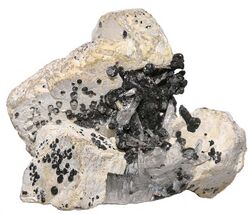Chemistry:Alamosite
From HandWiki
Short description: Colorless silicate mineral
| Alamosite | |
|---|---|
 Transparent crystals of alamosite in the matrix of leadhillite and melanotekite | |
| General | |
| Category | Inosilicates |
| Formula (repeating unit) | Pb12Si12O36 |
| Strunz classification | 9.DO.20 |
| Dana classification | 65.7.1.1 |
| Crystal system | Monoclinic |
| Crystal class | Prismatic (2/m) (same H-M symbol) |
| Space group | P2/c |
| Unit cell | a = 11.209, b = 7.041 c = 12.22 [Å]; β = 113.15°; Z = 12 |
| Identification | |
| Color | Colorless |
| Cleavage | {010} perfect |
| Mohs scale hardness | 4.5 |
| |re|er}} | Adamantine |
| Streak | White |
| Diaphaneity | Transparent to translucent |
| Specific gravity | 6.49 |
| Optical properties | Biaxial (−) |
| Refractive index | nα = 1.947, nβ = 1.961, nγ = 1.968 |
| Birefringence | δ = 0.021 |
| 2V angle | 65° (meas.) |
| References | [1][2] |
Alamosite (Pb12Si12O36) is a colorless silicate mineral named after the place where it was discovered, Álamos, Sonora, Mexico. It is a rare secondary mineral occurring in the oxidized zones of lead-rich deposits. For example, the infobox picture shows its association with black leadhillite.[1]
References
- ↑ 1.0 1.1 Alamosite. Webmineral. Retrieved on 2011-10-10.
- ↑ Alamosite Mineral Data. Mindat.org. Retrieved on 2011-10-10.
- ↑ Warr, L.N. (2021). "IMA–CNMNC approved mineral symbols". Mineralogical Magazine 85 (3): 291–320. doi:10.1180/mgm.2021.43. Bibcode: 2021MinM...85..291W.
 |

